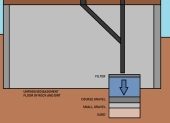
 1
1
















A human being should be able to change a diaper, plan an invasion, butcher a hog, conn a ship, design a building, write a sonnet, balance accounts, build a wall, set a bone, comfort the dying, take orders, give orders, cooperate, act alone, solve equations, analyze a new problem, pitch manure, program a computer, cook a tasty meal, fight efficiently, die gallantly. Specialization is for insects.
-Robert A. Heinlein








Rebecca Norman wrote:
We used a metal mesh, maybe low grade steel, with about 1 inch gaps. I'm sure it'll rust out, and then we'll find out if the wood chips can work without a mesh. Or we'll put in a plastic crate as the next mesh, since it will be protected from sun so it should be long lasting, I hope.
Kimi BrownKawa
https://www.brownkawa.com




Wendy Howard wrote:Only just saw this post! The OP is linking to an article I wrote for Permaculture Magazine back in 2014. Since then, the system has performed so well I introduced it to my local municipality here in Portugal. It's now approved for use under the provisions for 'septic tank with drainage', and is being installed by the council where septic tanks have failed or are non-existent. Many people in the area are also adopting it as a solution for their off-grid sanitation. I've open-sourced the system and there's now a website devoted to it. I'm gathering case studies of installations and encourage people to join the forum. The more experience gained, the more potential weaknesses are discovered and ironed out, the better the system becomes.




Julie Baghaoui wrote:Can we wash our gray water through the worm tank too (mainly Plain soaps for dishes clothes and washing) or will this be too much water passage ? Family of four plus visitors …

|
I don't always make ads but when I do they're tiny
2024 Permaculture Adventure Bundle
https://permies.com/w/bundle
|


